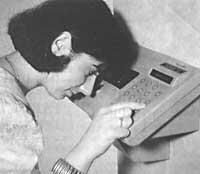Identification of hands and eyes
1990/09/01 Elhuyar Zientzia Iturria: Elhuyar aldizkaria
In companies, houses, buildings, etc. there are always aspects or special classrooms. The preservation of secrets, the existence of hazardous materials or any other circumstance makes access to these special places inconvenient.
In addition to placing key to the door, in recent years magnetic track cards have been used. The card reader receives the data at the door when the card enters the hole and conforms to the information it has recorded in memory, opens the door. However, this card has some drawbacks: the track can be demagnetized and the person has to carry the card over.
Since then magnetic induction cards have also been extracted, and its main advantage is that the card does not have to enter the reader hole. They are used by French motorway subscribers to pay the toll. This magnetic induction card approaches a glass and the data is automatically collected from behind the glass. Being based on an electronic chip is very difficult to fake induction cards, much more difficult than previous magnetic cards. However, both can be forgotten, lost or stolen.

To overcome all these obstacles, researchers are developing three systems based on biometrics: the one that analyzes the voice of the person, knows the shape of the hand and identifies the shape of the retina of the eye.
“Fichet” has developed the last two systems. The one who knows the shape of the hand has called ID3D and has a simple operation. First, the person who wants to access the special room must create a confidential code and then place their hand on a reader. There are camcorders that after “reading” the hand in three dimensions and converting the data into numbers are transmitted to the computer. Since the data of that specific person is already on the computer, they are compared and if they match the door opens. This system takes into account the volume parameters of the hand, so if the hand is stained with ink, bandaged or with ring on the finger, the door will open.
The identification of the retina is even more accurate; it can be said that it is like comparing the marks of the fingers. But analyzing the eye retina of the person is not easy and the researchers of “Fichet” have limited themselves to studying a piece of retina. The test device is not in contact with the eye. It should only be fixed at a light point on the screen.
The analysis of the retina is performed by infrared rays. A emitting diode explores the circular shape of the retina. Infrared rays are reflected and later, converted into numbers, the information is sent to the computer to compare it with the existing one.

Gai honi buruzko eduki gehiago
Elhuyarrek garatutako teknologia




